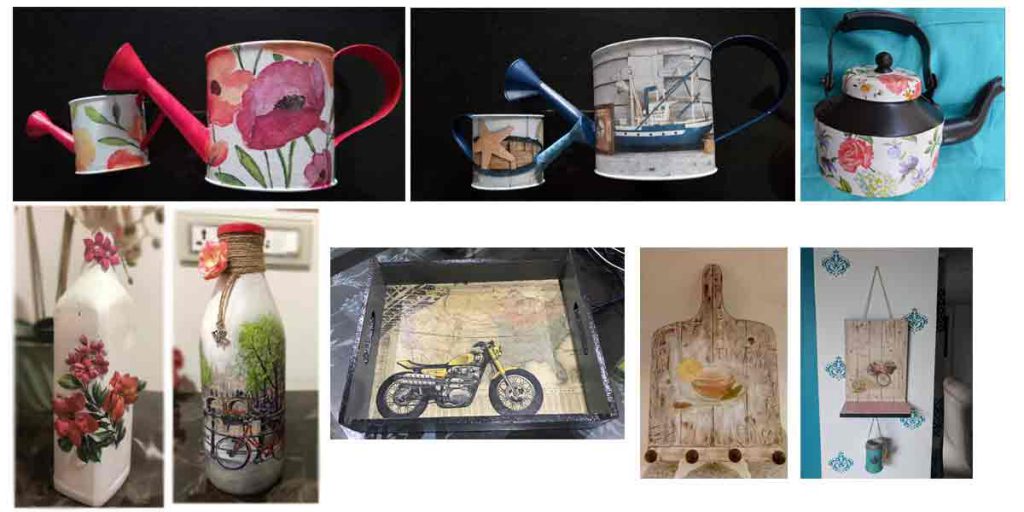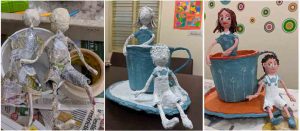Decoupage or Découpage (french term for “cutting out”) , the art of cutting and pasting cutouts to give painting effect to wood, metal or Glass. This art is very accessible craft for beginners. At the same time it has capabilities to take to artistic heights. Fine artists who practice this art are know as ‘decoupeurs’. Endless surface used for this art, but most common are : Furniture, wooden box, trays, Clear glass, metal, clay pots and wall art.
Origin of Decoupage
Art of Decoupage has a long and fascinating history. Even before the time of Christ, artist from eastern Siberia decorated objects. Later found in tombs with cutout felt figures and designs. The tombs date back to before Christ. From eastern Siberia this art spread to China. German and Polish artisans also used cut paper for decoration over several centuries. Polish women also developed art of decoupage skills. They folded coloured papers which they cut freehand into various geometrical shapes, designs. Shapes such as stylised birds, animals & flowers.
12th century Chinese peasants were creating paper cutout in vivid colors. Cutouts used to decorate various objects like, windows, lanterns, gift box and more. After a while artist’s began applying many layers of lacquer to make artwork durable and attractive.
From China to Europe
It was late 17th century, lacquer furniture from Far East became fashionable. In Europe , these furnitures were in high demand, resulted demand exceeded supply. As a result Venetian cabinet makes and lacquerers began to produce fake work to keep up the demand. This work named as lacca contrafatta-counterfeit lacquer. Many apprentices employed by artisans to hand color the prints and engravings of leading artists. These hand prints were than cut and pasted to the surface of object and covered with many layers of lacquer to produce furnitures. Apart from this development, wealthy classes hired master painters to decorate various objects. These included furnitures and to decorate there walls and ceilings.
Excessive demand and the fact many people cannot afford work of master. An alternative form of decoration developed. Drawings of the master artists were cut off, glued and covered with lacquer to resemble original paintings.
From this derivation came the alternative term l’arte del povero-poor man’s arts. It was during 17th and 18th century when this art form flourished throughout Europe. It even became famous at the court of Louis XV. Ladies with artistic bent snipped away at pictures and pasted them onto object. Some of the objects were hatbox, wig stand, fire screens and many more. Keeping themselves amused for hours.
Known Decoupage artists
Introduction to Decoupage cannot be complete without mentioning Mrs. Mary Delaney. Who lived in England from 1700 to 1788. This talented and charming woman was a confidante of Kind George III & Queen charlotte, a loved member of their court. At the age of 71, Mary started creating most exquisite and botanically accurate reproductions of plants and flowers. She cut the fine tissue papers which she painted first hand-coloured. She created 1,700 of these works, calling them her “Paper Mosaiks” , as she called, until the age of 88 when she succumbed to failing eyesight. These amazing paper cutouts can be seen in the British Museum today.
In 1760 a certain London printer, Robert Sayer, produced a much sought-after book called The Ladies Amusement or The Art of Japanning Made Easy. The book contained 1500 illustrations for artist craftsmen, but it was particularly popular with leisured ladies who loved to color, cut and paste the charming drawings. It also contained five pages of instructions on how to color, glue down, varnish and polish the cutouts. These instructions are preceded by “directions for composition” in which the reader is advised about the combination of subjects. “If the scene is European in the body of your design,” he directs to put in “no exotic or preposterous object…..We have seen a butterfly supporting an elephant and things equally absurd.”
Jay (Terry) Jones, a notable decoupeur from Waynesburg, Pennsylvania, holds multiple Guinness World records for his extensive decoupage collection.
Richard Basile, a well known New York art collector and entrepreneur, achieved notoriety as a decoupeur when his intricate floral decorative work.
Introducing Decoupage course for Beginners
At BrainArt HSR Layout Bangalore, introducing ‘Beginner course to Decoupage’. Mentor will assist students to learn this art and can beautify any space as they want. Decoupage beginner courses help a student learn specifics including:
Surface preparation
Cutting out the pictures
Picture arrangement
Gluing of the pictures
Varnishing to an adequate thickness
Who can attend the course : No experience or skill set required. Course will start from basic with lots of tips n tricks provided by mentor. This is a course that you can attend at BrainArt Studio in HSR Layout Bangalore
Initial use of decoupage for beginners involves 2D objects. Participants will learn about the progressive placement of identical images in decreasing size. All three surfaces will be covered in this course i.e, Glass, Metal & Wood.




